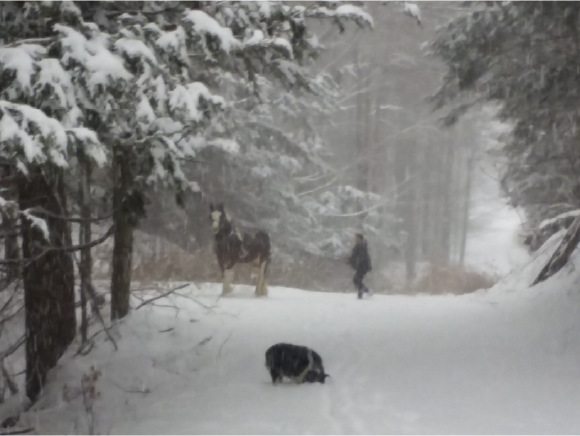The Wonderful Gypsy Horse
By Barb Elliot
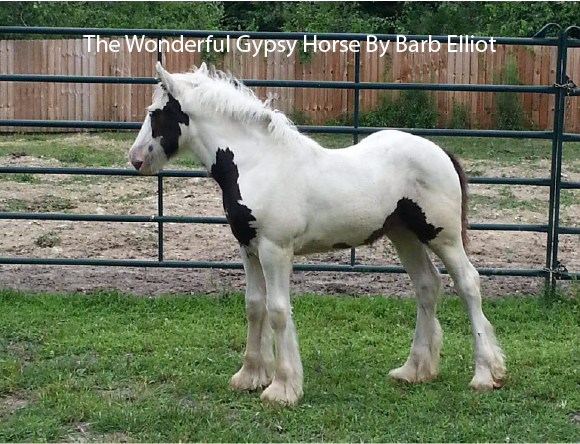
The very first Gypsy horse I ever saw was a picture sent to me from an online friend that lived in the hill country in England, Cumbria, I believe. This was back in the early 2000’s. She had actually come to visit America and was headed to a big cattle breeders meeting out West. She stopped at our dairy farm and milked with us in the parlor. She called our cows “hat-racks”. My friend was a beef breeder and also owned a LOT of sheep, maybe a couple thousand! She thought our sharp, hard working dairy cattle looked, literally, like a hat rack. I suppose, comparing her stout, round Limousin beefers to our dairy cows, they might have looked deficient to her.
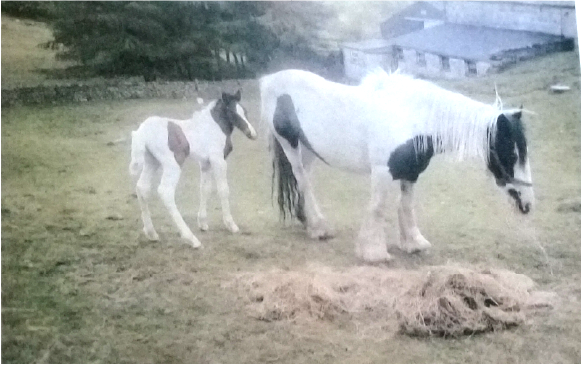
At any rate, she found out while she was visiting me in New York, that like her, I had a couple horses. She told me she owned ‘Vannahs,’ and I had to ask her to say it again because I had no idea to which breed she was referring. She repeated, “Vannahs!” A little slower and louder, so as I might understand it better, which, of course, I did not.
“VANNAHS woman. GYPSY VANNAHS. Good God woman, everybody knows what vannahs are!!”
I assured her I did not know, and I had to ask her to spell it for me. She showed me the picture of one of her mares with a foal at its side. That was my introduction to the world of a very special horse, the Gypsy Vanner/Gypsy/Cob/ Irish Cob/Tinker/Irish Tinker - and more names they go by.
After my friend left to go to her beef breeder conference, I did a little ‘research’ to see what I could find regarding the breed. The information I came across included their intriguing history, their ‘purpose’, their gentle demeanor that developed specifically for working closely with humans, and their beauty. It all pointed to something I was very interested in.
I have not owned a lot of horses in my lifetime, but the ones I have had have been very long term relationships (25-30 year ranges). And the horses I get stay with me for life. Although admittedly, at this point in my life now, I am beginning to believe my horses have a very good chance of outliving me. Something I failed to consider when I got these young horses 6 years ago and it really begs some serious planning what will happen to my beloved equines were something to happen to me. Facing one’s own mortality is not for the faint-of-heart.
Anyway, fast-forward to semi-retirement, which for most dairy farmers means one has sold off their cows but still has ownership in the farm. I had lost my ‘heart’ horse just at an age just shy of 30 years. I was devastated. He was an Arabian stallion and he had left a huge crater in my heart. I went 5 or 6 years without a horse, although I still had my daughter’s pony/horse at that point and that little mare was well into her late 20’s/early 30s. She was as tough as they come, having been kicked in the shoulder by a shod horse (ending up with a fracture in there somewhere), and basically becoming a three legged horse and surviving 5 years like that. But her time was close as her good shoulder and leg was starting to break down with the extra weight it had had to bear. A three legged horse is a miracle, two legged horses do not exist.I really needed something to occupy my free time.
My partner Richard had been diagnosed with Leukemia (which thankfully eventually went into remission), and I wasn’t getting younger. Coincidentally, at that time, I had a beloved and generous family member pass away that left me an amount of money. After paying off a late-in-life student loan that I had taken out to go to nursing school, to pay for my daughter’s car and my car, it seems I had a small amount left, which I, of course should have wisely invested.
The jury is out for most people whether my ‘investment’ was wise or not.
The purchase of three young horses, two Gypsy Vanner fillies and a Drum filly, has provided me with joy and experiences I would not trade for anything. Although it is not for everyone, there is something I find very satisfying about developing a relationship with an equine from as close to birth as one can get, up through and including the processes of gentling (‘breaking’, although I hate to use that term), driving/riding and maturity of a horse. Developing a language between the horse and myself feels very special and effectively communicating with another species always is exciting. I guess that is what has always drawn me to dressage, the unspoken language between horse and rider that looks so effortless but as we all know, takes years to develop.
But, back to the wonderful Gypsy horse. Before I started looking for my Gypsy horses, I needed to know what constituted a ‘good’ Gypsy horse! It always pays to do one’s homework! I tried to do some research into breed characteristics and ran into what I still consider one of the stumbling blocks for the breed in this country. I had imagined there would be one breed registry and instead I came across multiple registries in the USA. How could that happen? Which registry should I go by? Which registry was the best? Which registry was “THE” one to use? The breed had only been in the states less than 20 years. How did this happen?
But there are multiple registries to this day (not even counting the overseas registries!). I will leave it to each reader and potential owner to research and make up their own mind. I eventually settled into using the GVHS (Gypsy Vanner Horse Society) based in Florida. This organization was started by the man and wife team, Dennis and Cindy Thompson, who brought the very first Gypsy Vanners into this country in 1996 and delineated a breed description, including a reverence towards the actual people that had developed a history with the breed, the Romany peoples, or as many know them “The Travellers”.
Anyone can do a search to find the development of the breed going back to across the pond, the Romany people and Irish Cobs. It is a complex and interesting history. One of the more notable anecdotal parts helps explain why the ‘travellers’ opted to breed such colorful, patterned Tobiano types. During the 1st World War, the British government would come through town and commandeer private equine property in support of war efforts. But the government would only take solid dark colored horses, so the breeding of ‘colored cobs’ became a way of ensuring your own property would remain with you. Or so the story goes !
My experience with this breed has been nothing short of amazing. As a breed, they are extremely easy going, not all for sure as there are special apples in every bunch. But as an overall characteristic, it is predominant. One of the things the ‘travellers’ bred for was temperament. They worked with these horses every day, day in day out. They needed it to be easy as the horses were intimately part of their lives. This has become an identifying characteristic of the breed and it is to this day.
The Gypsy horses I own have been by far the easiest horses I have ever trained to pull things or drive than any other breed I have worked with. It is in them naturally. I routinely train all my young horses to drive, as it helps develop a great minded horse at a young age when they are still particularly ‘open to suggestion’. It helps form better habits and starts developing the language you will use when riding under saddle. It cements your relationship with your future mount and builds that all important ‘trust’ element, essential in getting the most out of your equine partner.
In picking out my horses, I wanted the best I could afford, and I would not buy without physically looking at them in the flesh. I reviewed some of what should been seen on a well-conformed Gypsy Vanner on the GVHS site, and then, I set out looking. Although I had owned geldings and stallions all my life, I decided I would like to eventually try my hand at breeding so I concentrated on looking for mares.
I found some closer breeders to my home (I live in upstate NY), but didn’t find anything that really caught my eye at that particular time. I reviewed more online ads (Facebook was a lot more, ‘lenient’ with regards to ‘for sale’ ads at that time), and after reviewing a lot of ads, I found a weanling filly with a decent pedigree in Delaware for what I thought was a reasonable price. Although I certainly would not say I was confident in extrapolating what a weanling would look like in adulthood, I went and looked at her. She was a pretty little blagdon filly and decided I like her enough so I paid a deposit to hold her for me and went home. Unfortunately, I didn’t have a hauler OR trailer. So I quickly went and bought a 16 ft stock trailer. It was all I could afford at that moment. I knew I would be transporting them at other times too, so I opted to purchase the trailer rather than pay a hauler. A few days later, with trailer in tow, I returned to Delaware and finished my purchase of the sweet blagdon filly.
I had started my Gypsy voyage! Being so young, I spent a lot of time with her. We walked the roadsides and the farm fields for miles and miles, practicing our developing ‘language’ and getting her used to the comings and goings of traffic and farm machinery. All the while continuing to look at other horses, their prices and locations.
I found a Gypsy breeder in Ohio that had a longer yearling I absolutely loved the looks of with a great pedigree and available for a little more money than I paid for my first baby. I went out to see her and liked her a lot, so I told the seller I was going to go home and get my trailer and be back. I put a lot of miles on my vehicle early that winter looking at and going to get horses! I told myself I would have my ‘herd’ by the first of the year. And I did. I had two beautiful Gypsy fillies!
I happened to come across a stunning picture of a yearling DRUM filly. Yes, a ‘Drum’ horse. What’s a “Drum’ horse you might ask? I asked myself that very same thing when I saw that picture. It’s another relatively unknown breed in this country but well known in the UK. Drum horses are a breed named for the job they do, the ceremonial carrying of the Queen’s kettledrums. Huge brass kettledrums (2 of them) per horse. The horses have to be big, sturdy and tractable for obvious reasons. While the rider is playing the 2 big kettle drums, he simultaneously steers the horses with the reins attached to his feet and stirrups. A Drum horse is made up of Shire, Gypsy, and Clyde genetics with no less than 6.25% and no more than 50% Gypsy genetics.
Anyway, a Gypsy breeder had offered her again for sale thru no fault of her own. She struck me as a horse with a lot of potential. I just loved her looks and how she was built. So she was the last of my herd. I drove to Indiana (stayed w a friend out there), and met the breeder (Kathy Ramey – also a well known Gypsy horse breeder) out there. I was more impressed in person than I was with her picture and took that as a promising sign.
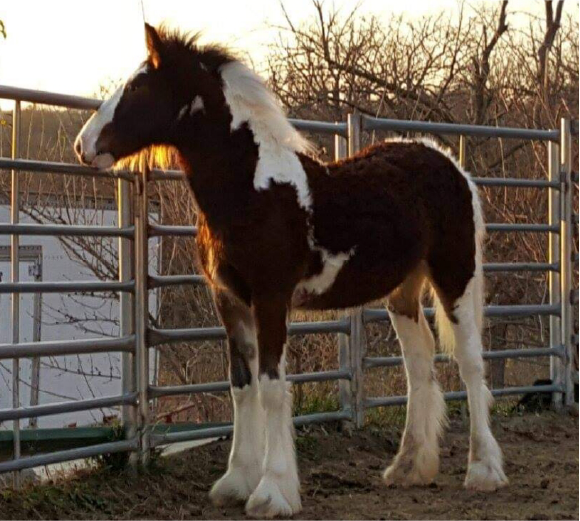
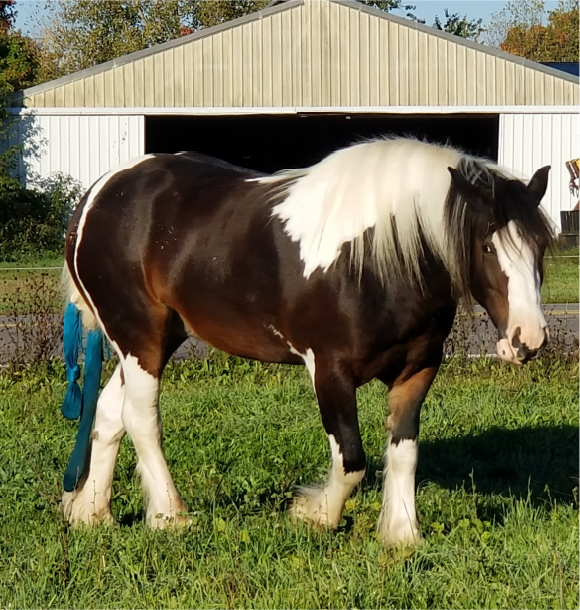
Fast forward 5 years and (I think!) we have done very well for ourselves. Copper and Meme have been to Equine Affaire multiple years in a row until Covid, and they do very well representing their respective breeds in the breed booths and in the breed demos. The breed booths can be an exhausting experience, but these two girls seem as interested in the people coming by as the people are in them. It’s a very accurate reflection of their genuine curiosity and outgoing social nature. Thousands of people a day come through the breed barns, reaching for, petting and handling the horses’ heads and it takes a special kind of horse to endure that extreme socialization without having negative consequences. They are perfect for the job.
I entered my very first horse show ever, the NEGHC breed show, with Meme when she was 3 years old. I showed my horses in nylon halters, brand new with matching lead ropes I might add, purchased from Tractor Supply on the way to the show. I showed both my Gypsy fillies and my Drum filly. Unfortunately, there were no other Drums there. It was like a fairy tale, a real Cinderella story. I took 1st and 2nd place in the 3-5 yr old Mare class (Meme 1st and my little blagdon Kelpie 2nd) and went on to take Grand Champion Mare(Meme) AND SUPREME CHAMPION!!!!! I had put Meme back in her stall after the Grand Champion class and had gone to call my husband with the exciting news. I was so excited. I did not even know there was a ‘Supreme Champion’ class! I had removed my show clothes and suddenly heard them calling my number over the loudspeaker to return to the ring with my horse. I was dead certain they were going to correct a mistake they had made and give the Grand Champion rosette to the rightful owner. Much to my surprise, we were named Supreme Champion/Halter (unanimous by two judges). Yes. I was dumbfounded, tearful, in my street clothes, and was so very proud of my hard working beautiful horse. And she has repeated this accomplishment in another NEGHC show this last year (also a unanimous decision by the judges) and taken Grand Champion Mare in a couple virtual shows this Covid plagued year.
Moral of the story: It pays to do your homework, research, and don’t buy the very first thing you come across. The Gypsy horses are all beautiful, but it is their curiosity and natural calmness that will win your heart. They are the absolute perfect family horse, and well worth the investment.
